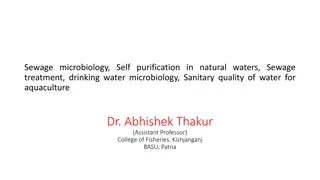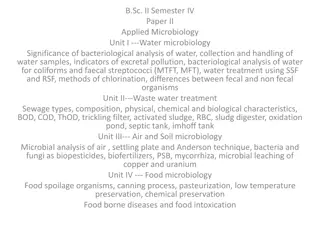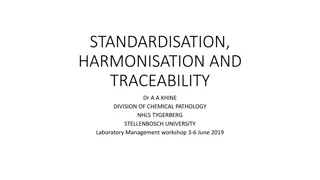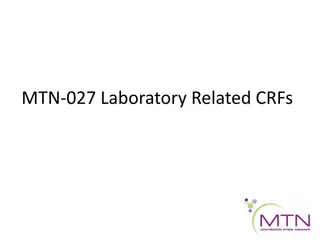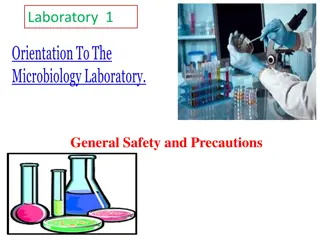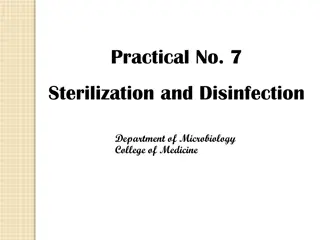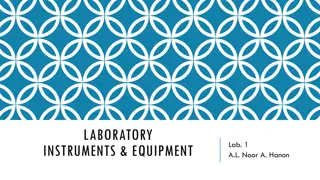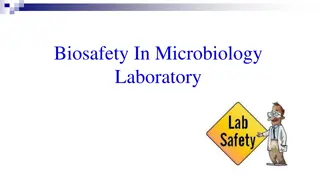
Bacterial Pathogens Associated with Infectious Scenarios
Discover the most common bacterial pathogens like Streptococcus pneumoniae, Haemophilus influenzae, and Mycobacterium tuberculosis in this comprehensive overview. Learn about their characteristics, transmission, and associated diseases such as pneumonia, epiglottitis, and tuberculosis.
Download Presentation

Please find below an Image/Link to download the presentation.
The content on the website is provided AS IS for your information and personal use only. It may not be sold, licensed, or shared on other websites without obtaining consent from the author. If you encounter any issues during the download, it is possible that the publisher has removed the file from their server.
You are allowed to download the files provided on this website for personal or commercial use, subject to the condition that they are used lawfully. All files are the property of their respective owners.
The content on the website is provided AS IS for your information and personal use only. It may not be sold, licensed, or shared on other websites without obtaining consent from the author.
E N D
Presentation Transcript
Case 3 Summary The Microbiology Laboratory Created by Christy Hui
Most common bacterial pathogens associated with infectious scenario are: Streptococcus pneumoniae Haemophilus influenza Mycobacterium tuberculosis
Gram positive, non-spore forming, non-motile cocci bacteria Alpha hemolytic: able to break down red blood cells via hydrogen peroxide Also causes damage to DNA and host cells Transmitted via direct contact with respiratory secretion such as mucus or saliva Streptococcus pneumoniae Community acquired pneumonia (CAP) is acquired outside of hospitals and healthcare settings Induces high fever, difficulty breathing, and rust-coloured sputum If left untreated, it can lead to chronic fever, pleuritic pain, arthritis, sinusitis, and septicemia
Opportunistic bacteria that results in pneumonia, epiglottitis, osteomyletis and bacteremia Six type of encapsulate H. influenza (a, b, c, d, e, f) Most common being type B (Hib) Transmission occurs via direct contact with respiratory fluids Haemophilus influenza Capsule has been shown to resist phagocytosis and complement- mediated lysis Adherence is mediated by trimeric auto-transporter adhesins found on the outer bacterial membrane Induces low-grade fever, wheezing, and grey or cream-coloured sputum
Non-spore forming, non-motile, rod shaped aerobic bacteria Infection occurs via tiny droplets released into the air by sneezing, coughing, speaking or singing Two phases: latent and active Latent: bacteria remains in host in an inactive state, does not cause disease Active: bacteria multiples and causes infection; may follow latent phase Mycobacterium pneumoniae Protein A promotes adherence while protein D inhibits phagocytosis Symptoms include coughing, chest pains (while breathing), fever, night sweats, chills, loss of appetite, weight loss, fatigue
Sampling methods used in diagnosing Tuberculosis: Sampling methods used in diagnosing pneumonia: a) Mantouxskin test a) TB Skin Test b) Interferon-gamma Release Assays (IGRAs) b) TB Interferon-gamma Release Assays (IGRAs) c) Sputum smear microscopy c) Sputum smear microscopy d) Bronchoalveolar lavage d) Gastric aspiration or washing e) Gastric aspiration or washing e) Chest X-Ray or Radiograph f) Pleural fluid g) Urine test
Tuberculosis Skin Test Mantouxtuberculin skin test Can be used to test for TB or pneumonia Injects tuberculin fluid into the skin of the arm If area of injection is raised and swollen, it is likely the individual is infected with tuberculosis Skin test has low specificity, it may produce false positives BCG, a vaccination against TB, may also false positive
Blood tests used to measure the immune response to infection Detects the levels of interferon gamma (IFN- ), which are only present during infection Only used to test latent TB Interferon Gamma Release Assays (IGRAs) A quick blood test done in a single visit
Sputum is a thick fluid buildup in the lungs as a response to pathogens in the respiratory track Collected by the patient coughing into a sterile cup Sputum Smear Microscopy Test Collected sputum is smeared onto a glass slide and examined under the microscope for signs of mycobacterium. Quick, efficient, cost-effective method of testing for TB Low sensitivity in testing, false positives may be produced Fluorescent microscopy can improve the accuracy However, this method is less cost efficient
Two types of BAL: Non-bronchoscopic: requires catheters insert through an endotracheal tube Bronchoscopic: uses a flexible bronchoscope to instill and withdraw saline solution Separation of mucus and BAL fluid (BALF) must take place through a filter of sterile cotton gauze or nylon mesh Bronchoalveolar lavage (BAL) Cellular components are then identified BALF can also be centrifuged for direct identification of pathogens BALF can be prepared two ways for analysis: Cyto-spin preparation of whole BALF Re-suspension of specimen in a small amount of medium, then centrifuged
Alternative method to collecting sputum from patients who are unable to cough up an adequate amount (i.e. children) Gastric Aspiration or Washing A tube is used to suck up the sputum swallowed into the stomach after coughing into the throat Procedure is done in the morning, over a span of three days, prior to breakfast to receive optimal samples
Chest X-Ray or Radiograph A diagnostic test used to visualize the inflammation of the lungs Abnormal shadow may be visible in the x-ray Lesions may also been seen These abnormalities normally occur in the apical and posterior region of the upper lobe or the superior segments of the lower lobe Likely signs of TB infection based on lesions such as mixed nodular and fibrotic lesions, which indicate a site of tubercle bacilli colonization and multiplication False positives may occur when not combined with genetic molecular testing or bacterial cultures This method may be expensive in less economically developed countries Arrow indicates lesion in the lungs
Pleural fluid Urine test Pleural fluid & Urine test A first morning sample (up to 40mL) should be collected over a span of three consecutive days. Pleural fluid should be collected anaerobically using a balanced heparinized blood gas syringe Samples should be refrigerated until processed.
General tests are performed to narrow down the pathogenic species: Catalase test Pleural fluid test Antibiotic sensitivity test Gram stain Oxidase test Agglutination
Catalase is produced by aerobic bacteria, used to breakdown hydrogen peroxide into water and oxygen. In order to determine if the bacteria colony is catalase positive, 3% hydrogen peroxide is added to the culture If catalase is present, bubbling with occur Catalase test
Pleural fluid can be used to determine if an infection is present Exudate fluid indicates an infection If infected with M. tuberculosis, pleural fluid will be a serous exudate If infected with S. pneumoniae, pleural fluid will be clear If infected with H. influenza, pleural fluid will be clear Pleural Fluid Test
This test is used to determine the appropriate antibiotic treatment Antibiotic Sensitivity Test Antibiotics are added bacteria cultures, then incubated for 18 hours Zone of inhibition is then measured, indicating the bacteria sensitivity to antibiotic
This test is used to determine whether a bacteria is gram positive or gram negative Gram Stain Bacteria is fixed onto a microscope slide, then applied with a primary stain Crystal violet stains the cells a purple or blue colour Organic solvent is then added to extract the blue dye from the cells Gram negative bacteria is decolourized, while gram positive bacteria remains blue Safranin counterstain is applied to colour gram negative cells red/pink, while gram positive cells remain blue
Used to determine the presence of cytochrome oxidase in bacteria This enzyme is used for electron transport chain Filter paper is soaked with tetramethyl-p-phenylenediamine dihydrochlorine and moistened with sterile distilled water Oxidase Test The bacteria of interest is then smeared onto the paper If it is oxidase positive, the area will become purple as the electron donor is oxidized
Saline solution is dropped onto a microscope slide A homogenous suspension is made with bacterial colony Agglutination A specific anti-serum is then added Visible clumping indicates a positive test
Streptococcus pneumoniae specific testing Streptococcus pneumoniae culture Optochin sensitivity test Bile solubility test Urinary antigen test
Streptococcus pneumoniae culture Streptococcus pneumoniae can be cultured on blood or chocolate agar plates in 5-10% CO2 environment Plates should be incubated at 37 c for 24-48 hours
Growth of S. pneumoniae can be inhibited in the presence of optochin Blood agar plate is inoculated with alpha-hemolytic isolates Optochin Sensitivity Test Optochin discs are applied to the plate and incubated at 37 c with 5-10% CO2 for 18-24 hours Zone of inhibition are then measured 14mm or greater confirms the presence of S. pneumoniae Zones between 9mm and 13mm requires further testing using bile solubility
Bile Solubility Test S. pneumoniae is lysed by bile Saline suspension of bacteria grown from blood agar is prepared and transferred into two tubes Turbidity should be 0.5 McFarlan standard 0.5mL of 2% sodium deoxycholate is added to one tube, 0.5mL of saline is added to the other The tubes are shaken and incubated for 2 hours If S. pneumoniae is present, the tube will become clear or lose turbidity
S. pneumoniae has a polysaccharide capsule that is detectable in the urine using an immunochromatographic membrane assay Test cards are prepared rabbit antibody specific for S. pneumoniae Urinary Antigen Test It is then combined with a membrane that has a rabbit-specific S. pneumoniae and left to equalize A urine swab is inserted to the hole on the card. Another reagent is added to another hole in the test card If S. pneumoniae is present, two pink or purple lines appear
Mycobacterium tuberculosis specific testing Mycobacterium tuberculosis culture Acid-fast smear IFN-gamma release assay Niacin test High-performance liquid chromatography
M. tuberculosis can be cultured on Lowenstein-Jenson medium or Middlebrook medium These mediums contain inhibitors to prevent bacteria other than M. tuberculosis from growing Colonies require 3-6 weeks to be visible Mycobacterium Tuberculosis Culture
M. tuberculosis can be stained after an acid wash Sodium hypochlorite is added to bacteria sample 8mL water is added and sample is centrifuged Acid-Fast Smear Remaining sediment is transferred to microscope slide and left to dry Finally the slide is stained using the Ziehl-Neelsen technique If M. tuberculosis is present, stain will turn the bacteria red
This test measures a patients immune response to Mycobacterium using IFN- as biomarkers A blood sample is collected and tested for the specific lymphocytes IFN-gamma Release Assay Previous vaccination of BCG does not interfere with test results Can be used in conjunction with the tuberculin skin test to diagnose Tuberculosis
Niacin is a metabolic by-product of M. tuberculosis Bacteria culture is swabbed onto filter paper with cyanogen bromide. Niacin Test If M. tuberculosis is present, the filter paper will become yellow
High Performance Liquid Chromatography This test is used to determine different species of the Mycobacterium based on cell wall composition Generated elution spectrums are observed M. tuberculosis is diagnosed with the presence of mycolic acid
Haemophilus influenza specific testing Haemophilus influenza culture X and V factor test
Haemophilus influenza culture H. influenza can be cultured on blood agar plates, incubated in 5- 10% CO2 at 37 c for 24048 hours
Bacterial colony is cultured on a Mueller Hinton agar plate X, V, and XV factor discs are placed onto the plate and incubated H. influenza will only grow around the XV disc. X and V Factor Test
General Tests Results Catalase test Positive Pleural fluid test Serous exudate Gram Stain N/A Oxidase test Negative Expected Results of M. tuberculosis Bacteria Specific Tests Results Niacin test Yellow Acid-fast smear Red IGRA Positive High Performance Liquid Chromatography Presence of mycolic acid indicates positive for M. tuberculosis
General Tests Results Catalase test Negative Pleural fluid test Clear exudate Gram Stain Positve Oxidase test Negative Expected Results of S. pneumoniae Bacteria-specific Tests Results Optochin Sensitivity Test Positive if < 14mm zone of inhibition Bile solubility test required if zone of inhibition is 9mm-13mm Bile Solubility Test Clear Urinary Antigen Test 2 pink lines
Tests Results Catalase test Positive Pleural fluid test Clear exudate Gram Stain Negative Oxidase test Positive Expected Results of H. Influenza X & V factors Grows only on XV area


